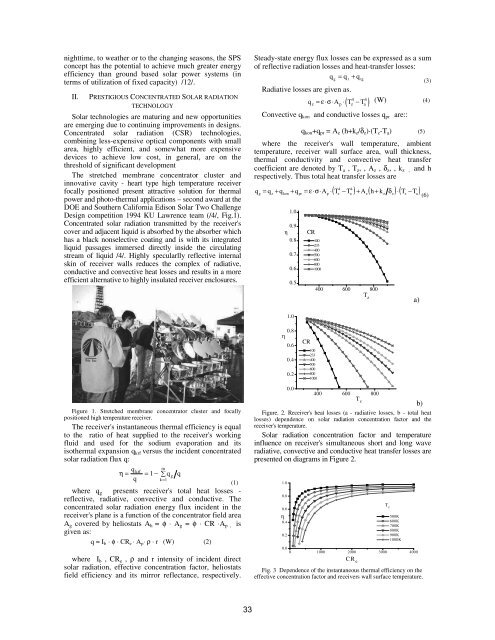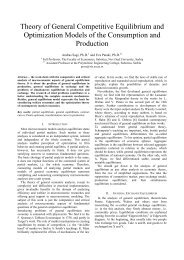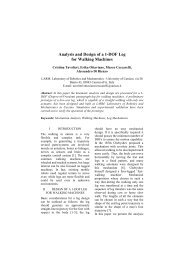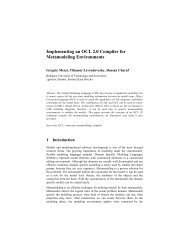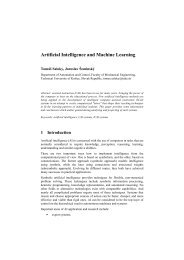AMTEC Solar Space/Terrestrial PowerGeneration and Wireless Energy Transmission –How Far Is The Realization?M.S. Todorović * , Z. Civrić ** and O. E. Djurić ****University of Belgrade, Serbia and Southeast University, Nanjing China**Museum of Science and Technology, Belgrade, Serbia***University of Belgrade, Serbiaderesmt@eunet.rs, zorica.civric@gmail.com, nera@agrif.bg.ac.rsAbstract— In this paper hybridization and cogenerationwith concentrated solar radiation (CSR) technology coupleda) with alkali metal thermoelectric conversion (AMTEC)and b) with combined AMTEC-steam power cycles(AMTEC/SPC) has been studied. Thermodynamic modelsof combined CSR - AMTEC system and CSR -AMTEC/SPC for the cogeneration of electric and thermalenergy, using hybridization of solar and fossil fuels, hasbeen analyzed. Parametric system analysis has beenperformed taking in account radiative - reflective losses andthermal energy losses by thermal radiation, convection andconduction. <strong>Final</strong>ly, a program, defined to evaluate thecommercial applications of these emerging hybrid solartechnologies is presented. <strong>Program</strong> includes the evaluationof case studies as possible sites for commercial hybrid solarenergy utilization.I. INTRODUCTIONVictor Hugo’s famous sentence “There is nothing morepowerful than an idea whose time has come” maychallenge the question “Solar Space/Terrestrial PowerGeneration and Wireless Energy Transmission – How faris the realization; and is the Earth energy sustainabilityreally reachable? Paper entitled “Elements of theConcept of Sustainability in the Works of Nikola Tesla”/10/ examines practical results and theoretical issues thatTesla dealt with and that could be attributed to theconcept of sustainability more than 100 years ago.Tesla`s patents and most important articles related toenergy were analyzed in search for ideas onsustainability: technology – energy transformation andtransmission, renewable sources, coal technologies, metalprocessing, electric vehicles, turbines, environment – theintegrated “whole” of planetary and human systems,forests and fresh water, production of ozone, society –human needs, behavior and health /10/.The role of Tesla’s scientific contribution becomesmore important from the perspective of contemporaryenergy standpoint, in the context of the need forsustainable development, as well as in the context ofsustainable science /10/. For Tesla the Sun is the mainsource that drives everything, it follows that we shouldpromote ways of getting more energy from the Sun. Tesladistinguishes a form of Sun energy obtained from burningmaterials like coal, wood, oil, from a form of Sun energythat is contained in the water, wind and ambient.Today, in the world substantial natural renewableenergy comes from hydropower sources, and a muchsmaller amount from geothermal power; however, theseare still only a modest fraction of the total. In addition, awide variety of Sun’s energy technologies – includingphotovoltaic arrays, fuel cells, and wind turbines – havebeen applied on Earth during the past several decades innewer renewable energy systems. Expectations is that fullcommercialization and spreading of use of theserenewable “green” energy technologies can makesubstantial contributions to meeting long-term energychallenges faced by the global economy. However, thesetechnologies can not provide the huge amounts of newand sustainable energy that will be needed in the comingdecades of 21 st century. Similar technologies applied inextraterrestrial space exposed to the extraterrestrial solarradiation, may be, could provide quantitatively andqualitatively (exergetic higher) more sustainable energyto Earth.Hence, it is crucial for the world to research, develop,demonstrate, commercialize and deploy more affordableand more sustainable Sun’s energy utilization technology– solar space power generation. Notwithstandingoptimistic claims to the contrary, it does not appear thatthere is at present a solution to these concurrentchallenges. AMTEC Solar Space/Terrestrial PowerGeneration and Wireless Energy Transmission could be asolution. Thus, we came to the crucial statement NikolaTesla made more than 100 years ago: “Besides progresstoward discovering different ways of solar energytransformation, the next progress in history was thediscovery of ways to transfer energy from one place toanother without transmitting the material which is sourceof energy.” Tesla suggested that the transfer of powerover long distances as we know, based on his invention,are to be replaced by wireless transmission whoseprinciples and methods he had also developed more than100 years ago.In the late 1960s, Dr. Peter Glaser of Arthur D. Littleinvented technically a fundamentally new solar approachto global energy /11/: the Solar Power Satellite (SPS).The basic concept of the SPS is as follows: a largeplatform, positioned in space in a high Earth orbitcontinuously collects and converts solar energy intoelectricity. This power is then used to drive a wirelesspower transmission (WPT) system that transmits the solarenergy to receivers on Earth. Because of its immunity to32
nighttime, to weather or to the changing seasons, the SPSconcept has the potential to achieve much greater energyefficiency than ground based solar power systems (interms of utilization of fixed capacity) /12/.II.PRESTIGIOUS CONCENTRATED SOLAR RADIATIONTECHNOLOGYSolar technologies are maturing and new opportunitiesare emerging due to continuing improvements in designs.Concentrated solar radiation (CSR) technologies,combining less-expensive optical components with smallarea, highly efficient, and somewhat more expensivedevices to achieve low cost, in general, are on thethreshold of significant developmentThe stretched membrane concentrator cluster andinnovative cavity - heart type high temperature receiverfocally positioned present attractive solution for thermalpower and photo-thermal applications – second award at theDOE and Southern California Edison Solar Two ChallengeDesign competition 1994 KU Lawrence team (/4/, Fig.1).Concentrated solar radiation transmitted by the receiver'scover and adjacent liquid is absorbed by the absorber whichhas a black nonselective coating and is with its integratedliquid passages immersed directly inside the circulatingstream of liquid /4/. Highly specularlly reflective internalskin of receiver walls reduces the complex of radiative,conductive and convective heat losses and results in a moreefficient alternative to highly insulated receiver enclosures.Steady-state energy flux losses can be expressed as a sumof reflective radiation losses and heat-transfer losses:qg= qr+ qtg(3)Radiative losses are given as.( )4 4q = ε⋅σ⋅A ⋅ T − T (W) (4)z p z aConvective q kon and conductive losses q pr are::q kon +q pr = A z (h+k z /δ z )·(T z -T a ) (5)where the receiver's wall temperature, ambienttemperature, receiver wall surface area, wall thickness,thermal conductivity and convective heat transfercoefficient are denoted by T a , T z , , A z , δ z , , k z , and hrespectively. Thus total heat transfer losses are4 4( ) ( δ ) ( )qg = qz + qkon + qpr = ε⋅σ⋅Ap ⋅ Tz − Ta + Az h+ kz z⋅ Tz −Ta(6)1.00.9η0.80.70.60.5CR1002334005006008001000400 600 800T z a)1.00.8η0.60.40.2CR1002334005006008001000Figure 1. Stretched membrane concentrator cluster and focallypositioned high temperature receiver.The receiver's instantaneous thermal efficiency is equalto the ratio of heat supplied to the receiver's workingfluid and used for the sodium evaporation and itsisothermal expansion q krf versus the incident concentratedsolar radiation flux q:qmkrfη = = 1 − ∑ q g qqk=1(1)where q g presents receiver's total heat losses -reflective, radiative, convective and conductive. Theconcentrated solar radiation energy flux incident in thereceiver's plane is a function of the concentrator field areaA g covered by heliostats A h = φ ⋅ A g = φ ⋅ CR ⋅A p , isgiven as:q = I b ⋅ φ ⋅ CR e ⋅ A p ⋅ ρ ⋅ r (W) (2)where I b , CR e , ρ and r intensity of incident directsolar radiation, effective concentration factor, heliostatsfield efficiency and its mirror reflectance, respectively.0.0400 600 800T z b)Figure. 2. Receiver's heat losses (a - radiative losses, b - total heatlosses) dependence on solar radiation concentration factor and thereceiver's temperature.Solar radiation concentration factor and temperatureinfluence on receiver's simultaneous short and long waveradiative, convective and conductive heat transfer losses arepresented on diagrams in Figure 2.1.00.80.6η0.40.2T z500K600K700K800K900K1000K0.00 1000 2000 3000 4000C R eFig. 3 Dependence of the instantaneous thermal efficiency on theeffective concentration factor and receivers wall surface temperature.33


